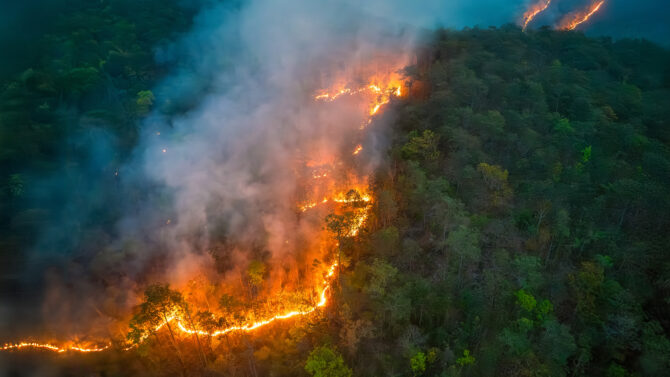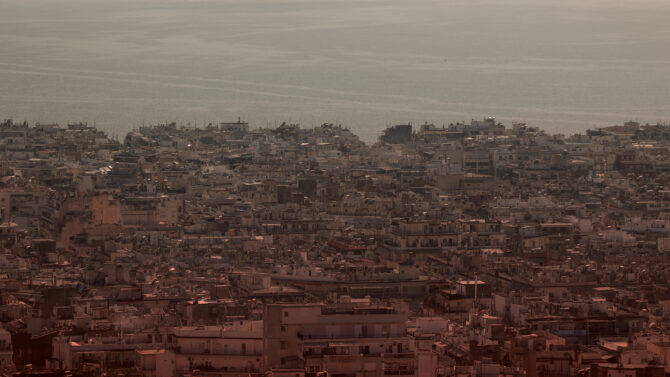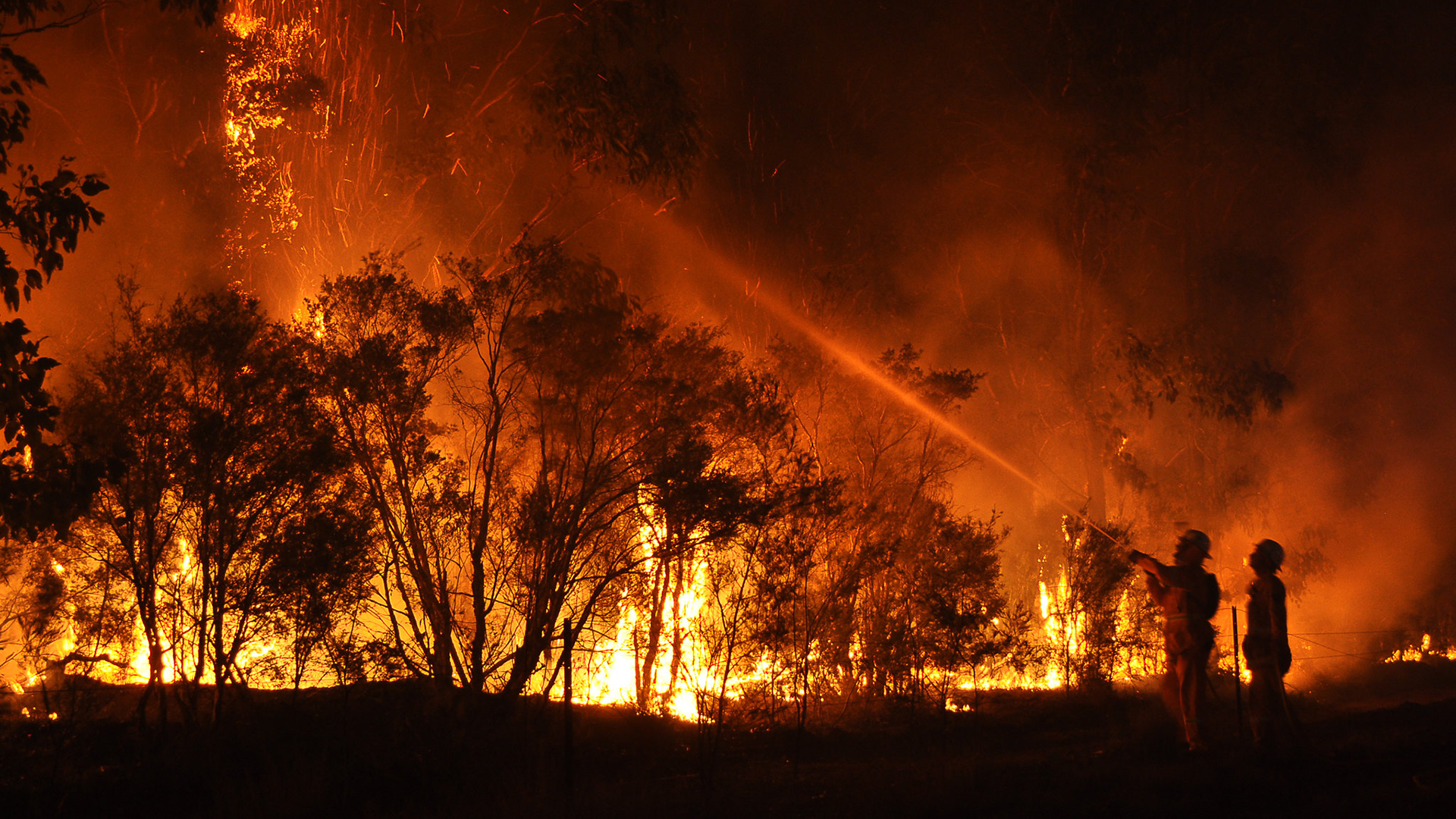This story was originally published on 3/9/2024 by GIJN and is hereby reproduced by iMEdD under a Creative Commons license. Read the original article here.
Main Image: Fire fighters from multiple task forces respond to a bushfire in Cessnock, New South Wales, Australia. Photo: Quarrie Photography / Flickr Creative Commons
Editor’s Note: This guide was prepared by Toby McIntosh, GIJN Senior Advisor, with contributions from many GIJN staff members. Thanks to Alcyone Wemaëre, Andrea Arzaba, Amel Ghani, Ana Beatriz Assam, Sheikh Sabiha Alam, Holly Pate, Pınar Dağ, Gabriela Manuli, Laura Dixon, Benon Herbert Oluka, Majdoleen Hassan, and Tri Joko Her Riadi. Editors of this guide included Nikolia Apostolou, Reed Richardson, and Alexa van Sickle.
GIJN also appreciates contributions from Joe Lo, a reporter for Climate Home News, and Laurie Goering, the extreme heat editor for Climate Resilience for All.
The examples in this guide are not news about the weather or stories on the latest scientific reports. but journalistic investigations about the effects of rising heat on humans.
New records for heat will probably be set this year, eclipsing 2023, which was the warmest year on record, according to Copernicus, the Earth observation component of the European Union’s space program. This continues the alarming trend where the 10 warmest years on record have occurred during the past decade.
The negative effects of higher temperatures can be seen everywhere, offering many opportunities for investigative journalism.
Climate Change Reporting and Mental Health: Practical Tips for Newsrooms and Journalists

Climate reporters face high anxiety, depression, and PTSD, yet they find strength in community and purpose in their work.
Some headlines have gained worldwide attention. In the summer of 2024, more than 1,300 people died from extreme heat exposure during the Hajj, the pilgrimage to Mecca in Saudi Arabia. In Mexico, howler monkeys became so dehydrated that they fell from trees and died.
The scale of global warming and its consequences are huge.
According to a report by Climate Central, a US non-governmental organization, “6.8 billion people — 78% of the world’s population — experienced at least 31 days of extreme heat” in the 12 months ending in May 2024. And heat waves are expected to claim approximately 1.6 million lives by 2050, according to a January 2024 World Economic Forum report, which also estimated that droughts will cause 3.2 million deaths by 2050.

These higher temperatures are caused by higher concentrations of heat-trapping gases in the atmosphere, driven primarily by human use of fossil fuels. These emissions have not only made temperatures hotter, but also led to more intense rainfall, deeper droughts, bigger wildfires, and stronger storms.
GIJN Guide: Ideas, Examples, Resources
This GIJN guide suggests multiple angles to investigating extreme heat as a global phenomenon.
The potential topics include:
- Examining the immediate medical consequences and the readiness of the medical infrastructure;
- Looking at the effects on workers, women, the poor, minorities, and other special populations;
- Investigating how heat is damaging crops, livestock and fisheries, and those who depend on them;
- Asking about how heat affects our societal infrastructure and what is being done to prepare for more heat;
- And much more — including sports, tourism, and biodiversity.
Local and regional news sites are dramatically examining these and many other subjects. There also have been global overviews about heat from major outlets like The Washington Post, Salon, and Rolling Stone.
To be clear, the investigative stories cited below are not news about the weather or stories on the latest scientific reports, although such coverage is critical. Nor is this guide about examining the causes of higher temperatures or the documenting of generalized impacts, such as rising sea levels and shrinking glaciers. (For more tips and resources on the former, see GIJN’s Guide to Investigating Sea Level Rise.) Instead, our examples are journalistic investigations about the effects of rising heat on humans.
Topics to Cover
Medical Consequences
- Immediate health emergencies: heat exhaustion and heat stroke, burns, etc.
- New transmission paths for infectious diseases.
- Respiratory and cardiovascular diseases rising because of wildfires.
- Mental health issues exacerbated.
- Increase in airborne allergens.
- Higher ground-level ozone, which causes higher levels of respiratory disease.
- People who are dependent on medical devices affected by blackouts.
- Measuring deaths from heat.
- Heat affects people with pre-existing conditions, such as the insulin levels of diabetics.
- Heat’s impact on pregnant women and embryos.
Examples
Why Is Cholera Killing Thousands in Southern Africa? – The New Humanitarian
The Killer Stalking Sri Lankan Men – The New York Times
Dengue Fever Is Surging Worldwide. A Hotter Planet Will Make It Worse – The Washington Post
For Aging Japan, a Troubling Link between Heat and Dementia – Japan Times
Heat Is Testing the Limits of Human Survivability. Here’s How It Kills – CNN
Persistent Wildfire Smoke Is Eroding Rural America’s Mental Health – Climate Central
Heat in Mexico Causes Record Number of Deaths in 2023 – Quinto Elemento Lab
Dengue Deaths Peak in 2023 in Two Eras, Factors Responsible – BBC (Bangladesh)
How Heat Affects The Brain – The New York Times
Taking The Climate Killers To Court – The Lever
‘When It’s This Hot, Time Stands Still’: Surviving West Africa’s Blistering Heat – The Guardian
Heat Kills Thousands in the US Every Year. Why Are the Deaths So Hard to Track? – The New York Times

Readiness of Medical Infrastructure
- Are doctors and hospitals prepared?
- Have governments prepared for heat emergencies?
- Have normally cool cities/states/countries understood they are also vulnerable?
Examples
Heat-Related Emergencies Are Soaring in the US Can Hospitals Keep Up? – The New York Times
Heatwave Puts Medicine Efficacy at Risk – The Business Standard (Bangladesh)
SOS from Hospitals: Heat, Outage and Rising Patients Choking Services – The Business Standard (Bangladesh)
Texas Likely Undercounting Heat-Related Deaths – Inside Climate News
Asphalt Burns, Delirium, Body Bags: Extreme Heat Overwhelms ERs Across US – The Guardian
Keeping the Homeless Hydrated in America’s Hottest Big City – Context, Thomson Reuters Foundation
Revealed: Three-Quarters of Prisons in England and Wales Face ‘High Risk’ of Overheating – CarbonBrief
Hot and Alone: How Us Cities Work to Protect Isolated People in Heatwaves – The Guardian
Labor Conditions
- How are various professions being affected: Construction workers, delivery workers, etc.
- Impact on gig workers as well as informal or undocumented workers with fewer labor rights.
- Rising workplace accidents and productivity losses because of heat-related sleepless nights.
- Are employers protecting workers? What else could they do?
- Are governments doing enough?
Examples
40 Degrees in the Factory: What Happens to Workers’ Health in the Era of Extreme Heat – Reporter Brasil
Saudi Delivery Drivers Bake in ‘Deadly’ Summer Heat – AFP
What It’s Like to Work in One of the Hottest Cities in South America – El Surtidor
The Story of a Heat Death: David Went to Work in his New Job on a French Building Site. By the End of the Day He Was Dead – The Guardian
For India’s Garbage Pickers, a Miserable and Dangerous Job Made Worse by Extreme Heat – AP
The US Has a Plan to Protect Workers from Heat. Employers are Fighting It – The Washington Post
Bangladeshi Garment Workers Fall Ill as Temperatures Soar – Context
The World’s Garment Workers Are on the Front Lines of Climate Impacts – Grist
The “Greenhouse Effect”: How an Oft-Touted Climate Solution Threatens Agricultural Workers – AP
Being a Delivery Driver, a Risky Job on an Increasingly Hot Planet – El Pais
‘You Feel Like You’re Suffocating’: Florida Outdoor Workers are Collapsing in the Heat Without Water and Shade – The Guardian
California Cuts Safety Enforcement as Farmworkers Toil in Extreme Heat – The Los Angeles Times (paywall)
‘Working Here Is Hell’: Latest Death of Farm Worker in 40C Heat Shocks Italy – The Guardian
HEAT HAVOC: Investigating The Impact On Street Vendors – Greenpeace

Water Reserves in Attica from 1985 to the Present Day

We have collected historical data on the water reserves in Attica’s reservoirs and are publishing it as an open dataset.
Differential Effects on Women, the Poor, and Minorities
- Identifying what areas are most affected by heat and who lives there.
- Exploring which special populations are most at risk.
- The increase in domestic violence during heatwaves.
Examples
‘Thermal Inequalities’ — Cape Town Heat Mapping Reveals Huge Temperature Differences Between Districts – The Daily Maverick
In Extreme Heat, People in Poorer, Urban Neighborhoods Suffer the Most – ecoRI (US)
Heat Inequality ‘Causing Thousands of Unreported Deaths in Poor Countries’ – The Guardian
Slow Wheels of Policy Leave Low-Income Residents of Nashville Feeling Brunt of Warming Climate – Inside Climate News
As US Heat Deaths Rise, Some Landlords Oppose Right to Air Conditioning – Reuters
On Beaches of Gaza and Tel Aviv, Two Tales of One Heatwave – Climate Home News
Heat Waves Can Be Deadly for Older Adults: An Aging Global Population and Rising Temperatures Mean Millions Are at Risk – The Conversation
Luxury or Lifeline? Why a Lack of Air Conditioning Can Be Deadly – The Telegraph
Saudi Visa Crackdown Left Heatwave-Hit Hajj Pilgrims Scared to Ask for Help – Climate Home News
Black Detroit Children with Asthma Hardest Hit by Seasonal Allergies – Bridge Detroit and Climate Central
We Need More Climate-Inclusive Death Data – Nonprofit quarterly
Kenyan Women Pay Harsh Price for Rising Heat: Lost Pregnancies – Climate Resilience
‘I Have to Ask My Husband for Literally Everything’: How a Warmer Climate Is Changing Gender Roles – CNN (India)
‘It’s Torture’: Brutal Heat Broils Texas Prisons, Killing Dozens of Inmates – The Guardian
Agriculture
- Effects on crops (lower yields, more weeds), and farmers.
- Effects on livestock, and ranchers.
- Effects on fisheries, and people working in the fishing industry.
Examples
‘The Adriatic Is Becoming Tropical’: Italian Fishers Struggle to Adapt to Warm Sea – The Guardian
Quantifying the Impact of Climate Change and Extreme Heat on Rice in the United States – Agricultural and Forest Meteorology
First Heat, Then Floods Wipe Out Farms in Pakistan’s Chili Capital – Dawn
Farmers in Mountainous Areas of Pakistan Feel the Heat – Dialogue Earth
Mangoes are Dropping in Intense Heat, Farmers Are Worried About the Production – Bangla Tribune
Extreme weather hits farmer (in Turkey): Not a single bunch of grapes in 60-ton vineyard – yeşilgazete
Shrimp Farmers Fear Losses for Scorching Heatwave – The Daily Star
The Whistleblower – The Outlaw Ocean Project
Five Charts: How Climate Change Is Driving up Food Prices around the World – CarbonBrief
Climate Change in Beaujolais: Could Gamay Disappear? – Rue89Lyon

Infrastructure
- Impact on electrical infrastructure.
- Damage to roads, rails, bridges, dams.
- Surging power and water demand during heat overwhelming supply.
- Lack of planning for energy spikes due to extreme heat.
Examples
Midwest Floods, Widespread Heat Waves Are Undermining US Transportation Systems – Inside Climate News
Stuck Bridges, Buckling Roads — Extreme Heat Is Wreaking Havoc on America’s Aging Infrastructure – The Conversation
The Surprisingly Simple Way Cities Could Save People from Extreme Heat – Grist
Taking a Train During a Heat Wave? Watch Out for ‘Sun Kinks’ – Grist
Sites with Radioactive Material More Vulnerable as Climate Change Increases Wildfire, Flood Risks – AP
Thousands of US Dams May Be Unprepared for Extreme Rain – The New Scientist
Planning and Solutions
- Homes and buildings are still being built using heat-absorbing materials, with big south-facing windows — showing a lack of awareness about the need to shift planning rules.
- Need for coordination between agencies dealing with extreme heat, water supply and firefighting, public transport, and sports or cultural events, etc.
- Need to rediscover older and cooler pre-air conditioning building designs.
- Housing construction in areas with inadequate water supplies is a threat in extreme heat.
- Planting trees in urban areas.
Examples
Cities Are Tackling Rising Heat — But They Have to Avoid a Dangerous Trap – The Guardian
As London Swelters, Adaptation to Heat Extremes Is Now ‘Urgent’ – Climate Resilience for All
Life in a Heat Dome: The American West Is Figuring Out How to Keep Cool – BBC
Can Chief Heat Officers Protect US Cities from Extreme Heat? – Grist
Water ‘Most Dear’ as Heatwave Sets In from Today – Dawn
The Capital Is Full of Trees That Are Not Suitable for the Environment – Prothom Alo
Philippine Heat Has Always Been a Problem — and It’s Going to Get Worse – Rappler

Sports
- What is the future of winter sports as record warming takes hold?
- Does the calendar for major sporting events — including the Summer Olympics — need to shift because of rising heat?
- What are the risks to amateur as well as professional athletes, and to school children?
Examples
Climate Change Is Putting Athletes and Their Sports at Risk – The Conversation
Athletes Find a Fierce Opponent in Climate Change – CBC
At the Olympics, Heat Can Raise the Danger Bar of Competitions – Inside Climate News
Extreme ‘Heat Dome’ Hitting Olympics ‘Impossible’ Without Global Heating – The Guardian
How Climate Change Threatens the Winter Olympics’ Future – The Conversation
As the World Heats Up, So Does the Debate around Artificial Turf – The New Lede
Investigating the Issue of Air Pollution in Thessaloniki and Ioannina

Journalist Sofia Christoforidou describes the story behind the report on air pollution in Thessaloniki and Ioannina. The investigation was conducted in collaboration with journalist Giorgos Tsantikos, as part of this year’s iMEdD incubator for local media.
Innovation to Reduce Risks — What Works and Doesn’t?
- Over-reliance on air conditioning expansion can drive more climate change and be at risk if power grids are overwhelmed or storms hit – and if air conditioning can be unaffordable in extreme heat.
- Importance of green areas, trees, water access in battling heat, with side benefits for biodiversity, mental health, etc.
- Shade structures, cooling spaces, green and white roofs.
- Cooling vests for workers, labor innovations, and heat insurance.
Examples
Extreme Heat Is Impacting Most Americans’ Bills’, Poll Finds – AP
A Third of Hurricane Beryl Deaths in Texas Were Caused by Heat – NBC News
From Insurance to ‘Digital Twins’, Innovation to Cut Heat Risks Is Warming Up – Climate Resilience for All
Eat or Stay Cool? Cities Test Ways to Protect the Poor from Rising Heat – Thomson Reuters Foundation
The Cost of Staying Cool: How Extreme Heat Is Costing Americans More Than Ever – USA Today
Other Impacts
- Economic
- National security
- Tourism
- Wild animals and plants
- Education
- Migration
Examples
Extreme Heat Poses New Challenge for Aid Agencies in Gaza – Context, Thomson Reuters Foundation
How an Era of Extreme Heat Is Reshaping Economies – Financial Times (paywall)
Extreme Heat Poses ‘Real Risk’ to Spain’s Mass Tourism Industry – The Guardian
How Rising Temperatures May Affect Future Elections – Nonprofit Quarterly
Extreme Heat Is Making Schools Hotter — and Learning Harder – The 19th
Tourists Are Feeling the Heat — and Their Bodies May Not Be Able to Catch Up – Inside Climate News
Heat Is Killing Thousands, and Big Events Have Not Adjusted – The New York Times
Extreme Heat Shuts Schools for Millions, Widening Learning Gaps Worldwide – Reuters
Hotter Temperatures Are Causing Trees to Have Heat Strokes – Sierra Club
Record Salmon Migration Runs Into Hot Water – E&E News
Heat Waves and Droughts Are a Bonanza for Junk Food Companies – The New York Times op-ed
Climate Change Is Filling the Greek Seas with Invasive Species – Efymerida ton Sindakton

Unusual Approaches
The Bureau of Investigative Journalism in the UK sponsored a community-based project to show “how hot people’s houses really get during a heatwave — and what this means for people’s health.” It invited public participation. The approach resulted in stories such as Stifling, Suffocating, Unliveable’: Life in an Overheating Home and Revealed: Escalating Effects of Hot Summers on UK Housing.
Resources
Heat and Health – The World Health Organization.
UNICEF – A report on how many children are affected by extreme heat.
International Labour Organization – “Working on a warmer planet,” a 2019 report.
Climate Shift Index – A global map by the US NGO, Climate Central.
Global Heat Health Information Network – Resources created by an independent, voluntary, and member-driven forum of scientists, practitioners, and policymakers.
Seven Lessons for Journalism in the Age of Extreme Heat – Members and alumni of the Oxford Climate Journalism Network met to explore heat and how to cover it.
World Weather Attribution – “Working with scientists around the world, WWA quantifies how climate change influences the intensity and likelihood of an extreme weather event in the immediate aftermath of the extreme event using weather observations and computer modeling.” See guide for journalists.
Quantifying the Impact of Climate Change on Human Health – A 2024 report published by the World Economic Forum.
Climate Change and the Escalation of Global Extreme Heat – A 2024 report produced in collaboration by Climate Central, World Weather Attribution, and the Red Cross Red Crescent Climate Centre.
Vital Signs – Research on deaths of migrant workers in the Gulf states, including a report called Killer Heat.
Extreme Precipitation in a Warming Climate – A report by the US NGO Climate Central, which also produced a guide, Extreme Weather Toolkit: Extreme Heat.
Extreme Heat and Your Health – US Centers for Disease Control
Countdown on Health and Climate Change: the Imperative for a Health-Centered Response in a World Facing Irreversible Harms – 2023 Lancet report
Persistent Urban Heat – A 2023 study in Science Advances, a journal that regularly publishes scientists’ findings about heat.
Climate Change Impacts by Sector – US EPA. Also by EPA, Climate Impacts on Human Health.
The Impact of Climate Change on Our Health and Health Systems – The Commonwealth Fund
Extreme Heat Is Breaking Global Records: Why This Isn’t ‘Just Summer,’ and What Climate Change Has to Do With It – The Conversation
The Emergence of Heat and Humidity Too Severe for Human Tolerance – Science Advances
Closer Limits to Human Tolerance of Global Heat – Proceedings of the National Academy of Sciences (US)
How Hot Is Too Hot for the Human Body? Our Lab Found Heat + Humidity Gets Dangerous Faster Than Many People Realize – The Conversation
Extreme Heat in Phoenix Could Make Outdoor Work ‘Impossible’ for Nearly Half the Year – Climate Analytics
National Integrated Heat Health Information System
Guidance and Best Practices on Visualizing Extreme Heat – ClimateVisuals.Org
News Sources
Society of Environmental Journalists – See a regularly updated collection of environmental stories. Search for “heat.”
Extreme Heat – A special section in the Guardian
Books
“The Heat Will Kill You First: Life and Death on a Scorched Planet” by Jeff Goodell
“On The Move: The Overheating Earth and the Uprooting of America” by Abrahm Lustgarten
“The Weight of Nature: How a Changing Climate Changes Our Brains” by Clayton Page Aldern
“Slow Burn: The Hidden Costs of a Warming World” by R. Jisung Park
“Warming Up: How Climate Change Is Changing Sport” by Madeleine Orr
“Heatwave: A Picture Book” by Lauren Redniss

